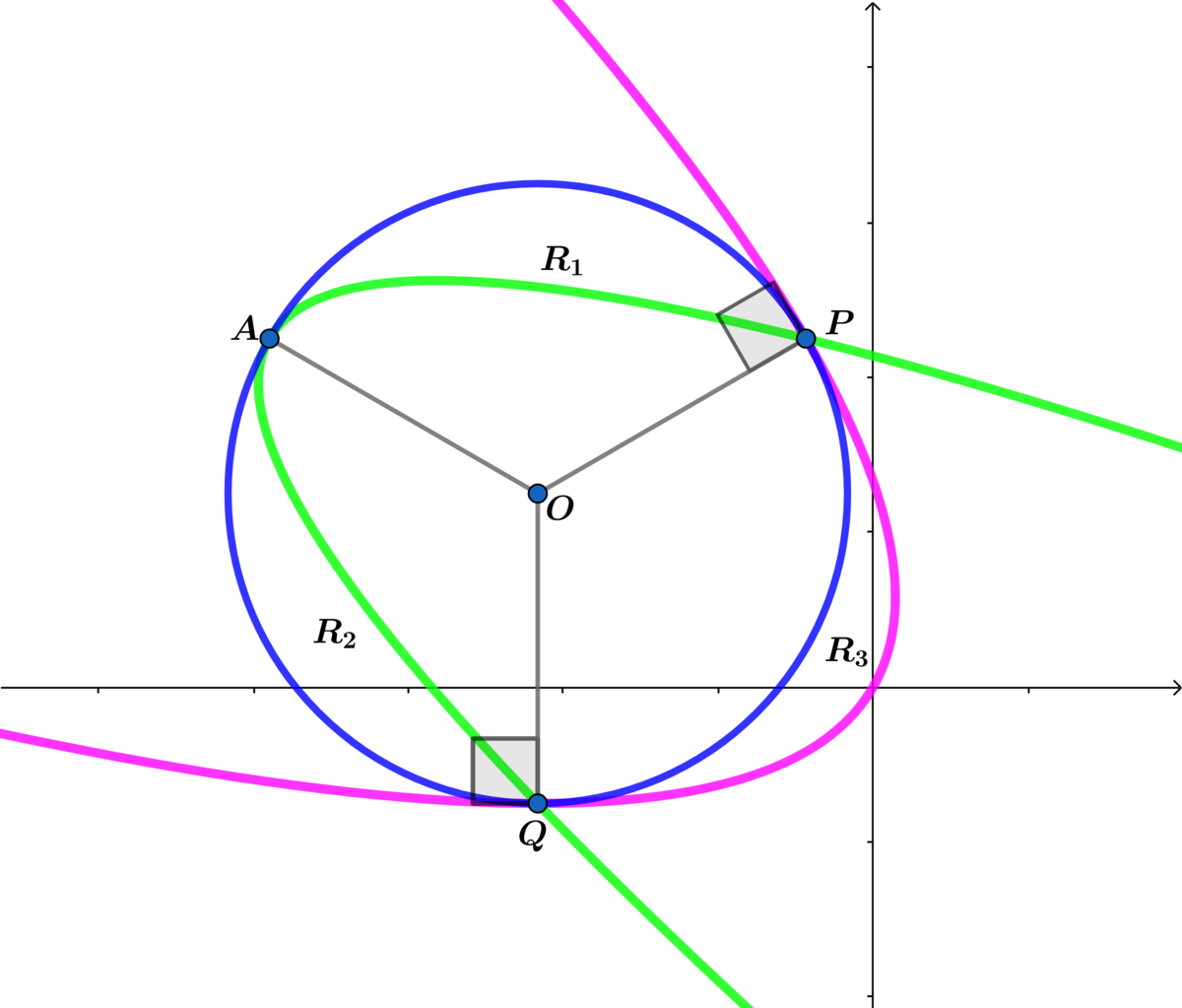Inscribed Circle!

The pink parabola is tangent to a circle with radius at points and as shown above and the green parabola intersects the circle at points and .
Find the sum of the areas of regions and .
The answer is 1.04719755.
This section requires Javascript.
You are seeing this because something didn't load right. We suggest you, (a) try
refreshing the page, (b) enabling javascript if it is disabled on your browser and,
finally, (c)
loading the
non-javascript version of this page
. We're sorry about the hassle.
Using the rotation equations:
x = x ′ cos ( θ ) − y ′ sin ( θ )
y = x ′ sin ( θ ) + y ′ cos ( θ )
For x 2 + 2 3 x y + 3 y 2 + 2 3 x − 2 y = 0 we have:
x ′ cos 2 ( θ ) − x ′ y ′ sin ( 2 θ ) + y ′ sin 2 ( θ ) + 3 ( x ′ 2 sin 2 ( θ ) + x ′ y ′ sin ( 2 θ ) + y ′ sin 2 ( θ ) ) +
2 3 ( x ′ y ′ cos ( 2 θ ) + ( x ′ 2 − y ′ 2 ) sin ( θ ) cos ( θ ) ) + 2 3 ( x ′ cos ( θ ) − y ′ sin ( θ ) )
− 2 ( x ′ sin ( θ ) + y ′ cos ( θ ) ) = 0
Setting x ′ y ′ term to zero we obtain:
2 sin ( 2 θ ) + 2 3 cos ( 2 θ ) = 0 ⟹ tan ( 2 θ ) = − 3 ⟹ 2 θ = 3 2 π ⟹ θ = 3 π
Replacing θ = 3 π in the above equation ⟹ 4 x ′ 2 − 4 y ′ = 0 ⟹ y ′ = x ′ 2
Similarly for − 2 x 2 − 4 3 x y − 6 y 2 + 2 3 x − 2 y + 9 = 0 we obtain y ′ = − 2 x ′ 2 + 4 9 .
Working from x ′ y ′ system and minimizing the distance O P we have:
D = d 2 = x ′ 2 + ( x ′ 2 − y 0 ′ ) 2 ⟹ d x ′ d D = x ′ ( 2 x ′ 2 − ( 2 y 0 ′ − 1 ) ) = 0 ⟹
x ′ = ± 2 2 y 0 ′ − 1 ⟹ 2 2 y 0 ′ − 1 + ( 2 2 y 0 ′ − 1 − y 0 ′ ) 2 = 1
⟹ 2 2 y 0 ′ − 1 = 4 3 ⟹ y 0 ′ = 4 5 ⟹ A : ( 0 , 4 9 ) and x ′ = ± 2 3
⟹ P : ( 2 3 , 0 ) and Q : ( − 2 3 , 0 ) and the equation of the circle in the x ′ y ′ system is
x ′ 2 + ( y ′ − 4 5 ) 2 = 1
For R 1 and R 2 :
I = 2 ∫ 0 2 3 ( − 2 x ′ 2 + 4 9 ) − ( 4 5 − 1 − x ′ 2 ) d x ′ =
2 ∫ 0 2 3 ( − 2 x ′ 2 + 1 + 1 − x ′ 2 ) d x ′ .
Letting x ′ = sin ( θ ) ⟹ d x ′ = cos ( θ ) ⟹
I = 2 ( ( − 3 2 x ′ 3 + x ′ ) ∣ 0 2 3 + ( 2 1 ( θ + 2 1 sin ( 2 θ ) ) ) ∣ 0 3 π ) =
2 ( 8 3 3 + 6 π ) = 4 3 3 + 3 π
⟹ A 1 = π − I = 3 2 π − 4 3 3
For R 3 :
For A 2 = 2 ∫ 0 2 3 ( ( 4 5 − 1 − x ′ 2 ) − x ′ 2 ) d x =
2 ∫ 0 2 3 ( 4 5 − x ′ 2 − 1 − x ′ 2 ) d x ′
Letting x ′ = sin ( θ ) ⟹ d x ′ = cos ( θ ) ⟹
A 2 = 2 ( 4 5 x ′ − 3 x ′ 3 ∣ 0 2 3 − 2 1 ( θ + 2 1 sin ( 2 θ ) ) ∣ 0 3 π ) =
2 ( 4 8 3 − 8 3 − 6 π ) = 4 3 3 − 3 π
A 2 = 4 3 3 − 3 π
⟹ the desired area A = A 1 + A 2 = 3 π ≈ 1 . 0 4 7 1 9 7 5 5